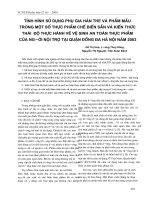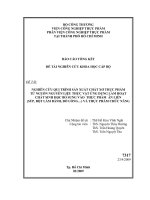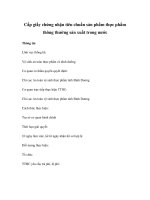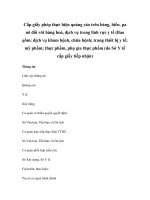Sự hiện diện integron nhóm 1 và vùng gen cassette ở các chủng salmonella đa kháng kháng sinh phân lập từ thực phẩm tại các chợ truyền thống trên địa bàn thành phố hồ chí minh
Bạn đang xem bản rút gọn của tài liệu. Xem và tải ngay bản đầy đủ của tài liệu tại đây (899.43 KB, 11 trang )
Scientific Research
Detection of class 1 integron-associated gene cassettes of multi-drug
resistant Salmonella strains isolated from food at conventional markets in
Ho Chi Minh city
Truong Huynh Anh Vu1*, Nguyen Hoang Khue Tu3, Huynh Yen Ha1, Chu Van Hai2
1
Microbiology laboratory, Center of Analytical Services and
Experimentation HCMC (CASE), Ho Chi Minh city, Vietnam,
2
Department of Science and Technology HCMC, Ho Chi Minh city, Vietnam
3
School of Biotechnology, Ho Chi Minh city International University,
Vietnam National University Ho Chi Minh city, Vietnam
(Received: 06/05/2022; Accepted: 06/06/2022)
Abstract
After Salmonella strains were isolated from food samples collected randomly at
conventional markets in several districts in Ho Chi Minh city, we evaluated antibiotic
resistance by Kirby-Bauer methods, and the serotype name was assigned according to
ISO/TR 6579-3:2014 and class 1 integron was investigated by PCR technique. As a result,
there were seven distinguished serovars, including S. Kentucky (8 strains); S. Infantis (4
strains); S. Agona and S. Potsdam (2 strains); S. Saintpaul, S. Braenderup, S. Indiana (01
strain); OMF:1,z6:UT and 7:1,z6:UT (01 strain). The rate of multidrug-resistance Salmonella
serovars carrying class 1 integron was 100% (21/21). The gene cassette region of class 1
integron accounted for 85.71% (18/21). The presence of mobile genetic factors in
Salmonella in the study suggests that the bacteria can transmit or receive antibiotic resistance
genes from other bacterial species in the natural environment. In addition, the research
results provide scientific evidence for management decisions and raise awareness of
effective antibiotic use in Ho Chi Minh City, Vietnam.
Keywords: Multidrug-resistance, antimicrobial resistance, Salmonella, integron, gene
cassette.
1. INTRODUCTION
Integron is a mobile genetic factor that plays an important role in the spread of
antibiotic resistance genes in Gram-negative bacteria, especially they are common in
bacteria of the Enterobacteriaceae family [1]. Integron has the ability to recognize and
capture 1 or more gene cassette regions, usually containing genes encoding antibiotic
*
Corresponding author: Tel +84 909182442
Email:
Vietnam Journal of Food Control - vol. 5, no. 2, 2022
129
Detection of class 1 integron-associated gene cassettes …
resistance [2]. Therefore, bacteria-carrying integrons often are multi-antibiotic resistant [3].
The general structure of the integrons consists of a conserved functional region 5'CS carrying
components necessary for the system to function and a variable region containing many
cassette genes encoding antibiotic resistance. The functional region of the integron includes
three important sites: the site carrying the tyrosine recombinase enzyme (IntI) gene, which
catalyzes the cleavage process and directs the binding of the integron of the cassette genes,
and the specific binding site of the attI cassette gene and promoter site (Pc) [4]. Integrons
themselves cannot move, but they are often associated with other movable genetic elements
such as jumping genes or conjugate plasmids, whereby they can spread antibiotic resistance
genes within and between species [5]. So far, at least 5 groups of mobile integrons have been
identified, of which group 1 and group 2 integrons are commonly present in bacteria with
multi-resistant phenotypes. They attract the attention of scientists because of their ability to
spread resistance genes that can occur within the same species and between species [6]. This
study was conducted to (i) identify serovars of Salmonella with multi-antibiotic resistance;
(ii) study on the presence of group 1 integron along with the cassette gene regions of multiantibiotic resistant serovars isolated from food at conventional markets in Ho Chi Minh City.
The research results will provide a scientific basis for future studies about the
mechanism of multi-antibiotic resistance of Salmonella spp. at the molecular level isolated
from food. In addition, the study supplements scientific evidence for state decisions on
management and raising awareness of effective antibiotic use in Vietnam in general and in
Ho Chi Minh City in particular.
2. MATERIALS AND METHODS
2.1. Objective
150 strains of Salmonella spp. isolated from food at traditional markets in Ho Chi Minh
City are kept in Cryobank tubes at -70°C at the Center for Analysis and Experimental
Services of Ho Chi Minh City.
2.2. Method
2.2.1. Evaluation of antibiotic resistance ability of Salmonella spp.
Take 3 - 5 pure colonies of each strain of Salmonella spp. on Nutrient Agar (Merck/ 1.05450)
to perform antibiotic susceptibility assessment by Kirby-Bauer method on Muller Hinton Agar
(Oxoid/CM0337). Based on the inhibitory zone diameter according to CLSI guidelines (2018) [7]
interpret the results of antibiotic sensitivity (R/I/S) of Salmonella.
The antibiotics used in this study were selected according to Decision 2625/QD-BNN-TY
[8]. Sterile antibiotic discs (Oxoid, UK) with a diameter of 6 mm were impregnated with antibiotic
solutions with the following concentrations: ampicillin (AM, 10 μg/mL), amoxicillin/clavulanic
acid (AMC, 30 μg/mL), ceftazidime (CAZ, 30 μg/mL), chloramphenicol (C, 30 μg/mL),
130 Vietnam Journal of Food Control - vol. 5, no. 2, 2022
Truong Huynh Anh Vu, Nguyen Hoang Khue Tu, Huynh Yen Ha, Chu Van Hai
ciprofloxacin (CIP, 5 μg/mL), ofloxacin (OFX, 5 μg/mL), gentamicin (CN, 10 μg/ mL),
streptomycin (STR, 10 μg/mL), nalidixic acid (NA, 30 μg/mL), tetracycline (TE, 30 μg/mL), and
sulfamethoxazole/trimethoprim (SXT, 30 μg/mL).
2.2.2. Total DNA extraction method
Using a circular culture rod, take a colony ring on Nutrient Agar (Merck/1.05450) and
place in Eppendorf containing 1 mL of sterile distilled water. DNA extraction was performed
using the AccuRive Bacteria DNA Prep Kit (KT Biotech) ( />2.2.3. Detection group 1 integron and cassette gene regions by PCR
For multi-antibiotic resistant Salmonella serovars isolated from food, the presence of
integron groups [9] and the cassette gene region were determined based on the use of
corresponding specific primer pairs by PCR [10]. The sequences of primer pairs and
amplification product sizes are shown in Table 1.
m-PCR reaction components include 2 UI AmpliTaq Gold; 0.2 mM dNTP; 1.5 mM
MgCl2; buffer 1X; 0.5 μL of each primer (concentration of 0.625 μM); 5 μL of template
DNA and 25 μL of deionized distilled water, amplification program on Mastercycler
(Eppendorf) was as follows:
For the determination of integron group 1: 94°C/5 min (1 cycle); 94°C/60s; 60°C/30s
and 72°C/60s (30 cycles); 72°C/05 min (1 cycle).
Positive control: Salmonella enterica subsp. enterica serovar Kentucky 1600.
For the detection of cassette genes: 94oC/05 min (1 cycle); 94oC/01 min, 58oC/02 min,
72oC/02 min (35 cycle); 72oC/10 min (1 cycle).
PCR products were determined by electrophoresis-UV on 1% agarose agar at 100V
for 30 min.
2.2.4. Electrophoresis method
PCR products were electrophoresed on a 1.5% agarose gel containing 1 µg/mL
ethidium bromide in TBE. Ladder ladders were also electrophoresed simultaneously.
Electrophoresis time was 35 - 40 min at 100 V and 100 mA. The gel was then photographed
with UV light using an Ingenius gel camera.
Table 1. Primer sequence used for PCR reaction
Target
Primer
Sequence 5'-3'
Integron group
1
Cassette
integron 1
Int1 F
Int1 R
5'CS
3'CS
CAGTGGACATAAGCCTGTTC
CCCGAGGCATAGACTGTA
GGCATCCAAGCAGCAAG
AAGCAGACTTGACCTGA
Size
(bp)
Ref
164
[9]
Variable*
[10]
Vietnam Journal of Food Control - vol. 5, no. 2, 2022
131
Detection of class 1 integron-associated gene cassettes …
3. RESULTS AND DISCUSSIONS
3.1 Antibiotic resistance phenotype of Salmonella strains
From the results of the antibiogram of 150 strains of Salmonella isolated from food,
we have determined the multi-antibiotic resistance phenotype of 21 strains of Salmonella
resistant to 07 antibiotics or more, this result was presented in Table 2. Thereby, it showed
that Salmonella strains isolated from fish samples have more antibiotic-resistant phenotypes
than other samples, specifically AMP, C, NA, GM, STR, TE, SXT (04 strains), AMP, C
phenotypes. , NA, CIP, OFX, GM, STR, TE (02 strains) and AMP, C, NA, CIP, OFX, GM,
STR, TE, SXT (03 strains), followed by Salmonella isolated from chicken samples have
antibiotic phenotypes AMP, CAZ, C, NA, CIP, OFX, GM, STR, TE, SXT (02 strains); AMP,
C, NA, GM, STR, TE, SXT (02 strains). Particularly, 03 strains with symbols SA07/20 1066,
SA07/20 1067 derived from chicken, and SA11/19 3514 from fish have the same antibiotic
resistance phenotype: AMP, CAZ, C, NA, CIP, OFX, GM, STR, TE, SXT.
Table 2. Multi-antibiotic resistance phenotype of Salmonella spp.
Source
Strain code
SA11/19
Pork
3497
SA11/19
4221
Beef
SA07/20
3335
SA11/19
3498
SA12/19
1584
Chicken
meat
SA05/20
1114
SA07/20
1066
SA07/20
1067
Antibiotic resistance phenotype
Number
of strain
AMC, AMP, C, NA, CIP, OFX, STR, TE
2/21
CAZ, C, NA, CIP, OFX, GM, STR, TE, SXT
AMP, C, NA, CIP, OFX, STR, TE, SXT
1/21
AMC, AMP, CAZ, C, STR, TE, SXT
AMP, C, NA, GM, STR, TE, SXT
AMP, C, NA, GM, STR, TE, SXT
AMP, CAZ, C, NA, CIP, OFX, GM, STR, TE,
SXT
AMP, CAZ, C, NA, CIP, OFX, GM, STR, TE,
SXT
132 Vietnam Journal of Food Control - vol. 5, no. 2, 2022
5/21
Truong Huynh Anh Vu, Nguyen Hoang Khue Tu, Huynh Yen Ha, Chu Van Hai
Source
Strain code
Antibiotic resistance phenotype
SA11/19
AMP, CAZ, C, NA, CIP, OFX, GM, STR, TE,
3514
SA11/19
3515
SA11/19
4205
SA12/19 501
SA12/19
1600
SA01/20 66
Fish
SA02/20
1524
SA05/20 210
SA06/20
1808
SA06/20
1809
AMP, C, NA, CIP, OFX, GM, STR, TE, SXT
AMP, C, NA, CIP, OFX, GM, STR, TE, SXT
AMP, C, NA, CIP, OFX, GM, STR, TE
AMP, C, NA, CIP, OFX, GM, STR, TE
AMP, C, NA, GM, STR, TE, SXT
AMP, C, NA, GM, STR, TE, SXT
13/21
AMP, C, NA, GM, STR, TE, SXT
AMP, C, NA, CIP, GM, STR, TE, SXT
AMP, NA, CIP, GM, STR, TE, SXT
AMP, C, NA, CIP, GM, STR, TE
SA07/20 462
AMP, C, NA, CIP, OFX, GM, STR, TE, SXT
2058
of strain
SXT
SA07/20 460
SA08/20
Number
AMP, C, NA, GM, STR, TE, SXT
Note: AMC (Amoxicillin/ Clavunic acid), AM (Ampicillin), C (Chloramphenicol), NA
(Nalidixic acid), CIP (Ciprofloxacin), OFX (Ofloxacin), GN (Gentamycin), STR
(Streptomycin), TE (Tetracycline), SXT (Sulfamethoxazole/Trimethoprim)
3.2 Results of serovar determination of Salmonella spp. multi-antibiotic resistance
From the results of determining the multidrug resistance phenotype, serovar
determination of 21 Salmonella strains was performed according to ISO/TR 6579-3:2014
using antisera O and H by agglutination reactions on glass slides and in vitro [11]. The results
in Table 3 showed that 07 serovars have been identified, of which the most is Kentucky
serovar (8 strains); Infantis (4 strains); Agona and Potsdam (2 strains); remaining each strain
Vietnam Journal of Food Control - vol. 5, no. 2, 2022
133
Detection of class 1 integron-associated gene cassettes …
for the serovar Saintpaul, Braenderup, Indiana. However, for two Salmonella strains with
symbols SA07/20 460 and SA07/20 462 isolated from seafood samples, serovar could not
be recognized (during the H antigen agglutination test, the process phase transition did not
occur) so only the antisera formulas were determined as OMF:1,z6:UT and 7:1,z6:UT.
Table 3. Results of serovar determination of Salmonella spp. multi-antibiotic resistance
Antigen formula
Source
Pork
Beef
Chicken
meat
Fish
Strain code
H antigen
O
Formula
Serovar
antigen
Phase 1
Phase 2
SA11/19 3497
8
i
1,z6
8:i:1,z6
S. Kentucky
SA11/19 4221
4
z
1,7
4:1,7:z
S. Indiana
SA07/20 3335
7
r
1,5
7:1,5:r
S. Infantis
SA11/19 3498
4
f,s,g
4:f,s,g
S. Agona
SA12/19 1584
7
r
1,5
7:1,5:r
S. Infantis
SA05/20 1114
7
l,v
en,z15
7:L,v:en,z15
S. Potsdam
SA07/20 1066
8
i
1,z6
8:i:1,z6
S. Kentucky
SA07/20 1067
8
i
1,z6
8:i:1,z6
S. Kentucky
SA11/19 3514
8
i
1,z6
8:i:1,z6
S. Kentucky
SA11/19 3515
4
eh
1,2
4:eh:1,2
S. Saintpaul
SA11/19 4205
7
e,h
e,n,z15
7:e,h:e,n,z15
S. Braenderup
SA12/19 501
8
i
1,z6
8:i:1,z6
S. Kentucky
SA12/19 1600
8
i
1,z6
8:i:1,z6
S. Kentucky
SA01/20 66
7
l,v
en,z15
7:L,v:en,z15
S. Potsdam
SA02/20 1524
8
i
1,z6
8:i:1,z6
S. Kentucky
SA05/20 210
7
r
1,5
7:1,5:r
S. Infantis
SA06/20 1808
4
f,s,g
4:f,s,g
S. Agona
SA06/20 1809
7
r
7:1,5:r
S. Infantis
SA07/20 460
OMF
1,z6
OMF:1,z6:UTa
-
SA07/20 462
7
1,z6
7:1,z6:UTa
-
SA08/20 2058
8
i
8:i:1,z6
S. Kentucky
1,5
1,z6
a
Note: : No classification
The results also showed that 100% of serovar were resistant to STR and TE. The
antibiotic with the least serovar resistance rate was AMC 9.52% (2/21), followed by CAZ
23.81% (5/21). This shows that AMC and CAZ antibiotics are still effective against isolated
multi-resistant serovars. S. Indiana, S. Infantis, S. Saintpaul, S. Braenderup had AMC
134 Vietnam Journal of Food Control - vol. 5, no. 2, 2022
Truong Huynh Anh Vu, Nguyen Hoang Khue Tu, Huynh Yen Ha, Chu Van Hai
sensitivity rate of 100.0%, S. Agona 50.0%, S. Kentucky 5.26%. Particularly, S. Kentucky
has the symbol 07/20 1066; 07/20 1067 and 12/19 1600 had the highest number of resistant
antibiotics (10 types).
Table 4. Number of multi-antibiotic resistant serovars sorted by source
Serovar
Pork
Beef
Chicken meat
Fish
(n = 2)
(n = 1)
(n = 5)
(n = 13)
Number
Rate
(%)
Number
Rate
(%)
Number
Rate
(%)
Number
Rate
(%)
S. Kentucky
01
50,0
-
-
02
40,0
05
38,46
S. Indiana
01
50,0
-
-
-
-
-
-
S. Infantis
-
-
01
100,0
01
20,0
02
15,38
S. Agona
-
-
-
-
01
20,0
01
7,69
S. Saintpaul
-
-
-
-
-
-
01
7,69
S. Braenderup
-
-
-
-
-
-
01
7,69
S. Potsdam
-
-
-
-
01
20,0
01
7,69
OMF:1,z6:UTa
-
-
-
-
-
-
01
7,69
7:1,z6:UTa
-
-
-
-
-
-
01
7,69
2/21
9,52
1/21
4,76
5/21
23,81
13/21
61,90
Tổng (n = 21)
In addition, the study results noted that Salmonella spp. from fish samples with the
highest number of multi-antibiotic resistant serovars, 61.90% (13/21 strains), followed by
chicken strains 23.81% (5/521 strains), pork 9.52% (2/21), finally beef 4.76% (1/21).
S. Kentucky was the predominant serovar in all three sources (pork: 01; chicken: 02; fish:
05 strains), only Salmonella from beef did not detect Kentucky serovar (Table 4). The results
partly reflect that the situation of multi-antibiotic-resistant Salmonella isolated from fish,
chicken, and pork meat sold at traditional markets in Ho Chi Minh City is alarming and
warning to consumers. On the other hand, the stronger participation of all levels of
management is really urgent in the current period.
3.4. Detection results of integron and cassette gene regions
The results in Table 5 show that group 1 integrons was found in all multi-antibiotic
resistant Salmonella serovars isolated from food groups. Group 1 integrons are commonly
present in multidrug-resistant bacteria and are detected in many Gram-negative bacteria [1].
In addition, their presence can significantly contribute to the horizontal gene transfer of
resistance genes between bacterial species from different sources or geographical regions.
Vietnam Journal of Food Control - vol. 5, no. 2, 2022
135
Detection of class 1 integron-associated gene cassettes …
The amplification results with primers 5'CS and 3'CS showed that the cassette gene
region was detected in 18/21 Salmonella strains (85.71%) with 08 different sizes (> 1.0 kbp;
1.0). kbp; 0.9 kbp; 0.6 kbp; 0.5 kbp; 0.4 kbp; 0.25 kbp; 0.2 kbp). The most amplified region
is 0.6 kbp (9/21, 42.86%), followed by 1.0 kbp (7/21, 33.33%), 0.25 kbp (6). /21, 28.57%),
0.9 kbp (5/21, 23.81%), > 1.0 kbp (4/21, 19.05%) 0.4 and 0.2 kbp (2/ 21, 9.53%) and the
lowest is 0.5 kbp (1/21, 4.76%). The proportion of Salmonella serovars that did not carry the
cassette gene region of integron 1 was 14.29% (3/21), carrying 4 regions at the same time
was 4.76% (1/21), 3 and 2 regions are 23.81% (5/21), 1 region 33.33% (7/21). The cassette
gene region > 1.0 kbp was mainly present in Kentucky serovars with a rate of 50% (4/8),
these serovars all shared the same phenotype of resistance to β-lactam antibiotics and
aminoglycosides.
All serovars containing the 0.9 and 1.0 kbp integron cassette gene regions of group 1
were resistant to quinolones, tetracyclines, and sulfonamides. From the analyzed data, we
determined that there is a correlation between the integron containing the cassette gene
regions and the resistance to AM, NA, CIP, SXT, STR, GM, and TE of the serovars isolated
from food. This has also been explained by previous studies, most of the cassette gene
regions bind to integron 1 of many bacterial species carrying genes for resistance to βlactams, quinolones, aminoglycosides, and tetracyclines [6, 12]. However, the difference in
the occurrence rate, as well as the combination and arrangement of genes in the gene cassette
region in bacteria, has so far not been proven. Therefore, further studies need to be done to
elucidate this issue.
Table 5. Presence of cassette gene regions belonging to integron 1 of Salmonella
Source
Pork
Beef
Chicken
meat
Fish
Cassette gene region size
Strain code
Serovar
Int 1
SA11/19 3497
S. Kentucky
+
-
SA11/19 4221
S. Indiana
+
0,25
SA07/20 3335
S. Infantis
+
1,0; 0,9
SA11/19 3498
S. Agona
+
0,25
SA12/19 1584
S. Infantis
+
1,0
SA05/20 1114
S. Potsdam
+
1,0; 0,6; 0,25
SA07/20 1066
S. Kentucky
+
> 1,0; 0,6
SA07/20 1067
S. Kentucky
+
> 1,0; 0,6; 0,4
SA11/19 3514
S. Kentucky
+
-
SA11/19 3515
S. Saintpaul
+
0,2
SA11/19 4205
S. Braenderup
+
1,0; 0,2
136 Vietnam Journal of Food Control - vol. 5, no. 2, 2022
(kbp)
Truong Huynh Anh Vu, Nguyen Hoang Khue Tu, Huynh Yen Ha, Chu Van Hai
Source
Cassette gene region size
Strain code
Serovar
Int 1
SA12/19 501
S. Kentucky
+
> 1,0
SA12/19 1600
S. Kentucky
+
-
SA01/20 66
S. Potsdam
+
2,5
SA02/20 1524
S. Kentucky
+
0,6; 0,4
SA05/20 210
S. Infantis
+
1,0; 0,9; 0,6
SA06/20 1808
S. Agona
+
0,6; 0,25
SA06/20 1809
S. Infantis
+
1,0; 0,9; 0,5
SA07/20 460
OMF:1,z6:UT
+
0,6
SA07/20 462
7:1,z6:UT
+
1,0; 0,9; 0,6; 0,25
SA08/20 2058
S. Kentucky
+
> 1,0; 0,9; 0,6
(kbp)
4. CONCLUSION
Research has shown the multi-antibiotic resistance of Salmonella serovars and an
increasing trend with multiple antibiotics. In addition, we detected the presence of group 1
integron in 100% of multi-antibiotic-resistant Salmonella along with 08 different cassette
gene regions in 85.71% of the total strains. The research results are intended to provide data
for scientists to conduct further studies on the mechanism of multi-antibiotic resistance at
the molecular level. At the same time, investigating the presence of other groups of
integrons, and studying the characteristics of the gene cassettes of Salmonella isolated from
food is also necessary and worthy of attention.
ACKNOWLEDGMENTS
This study was supported by funding from the contract science and technology
assignment No. 70/2019/HD-QPTKHCN.
REFERENCES
[1]. A. C. Fluit and F. J. Schmitz, “Class 1 integrons, gen cassettes, mobility, and
epidemiology,” European Journal of Clinical Microbiology and Infectious Diseases,
vol 18, pp. 761-770, 1999.
[2]. G. Cambray, A. M. Guerout and D. Mazel, “Integrons,” Annual Review of Genetics,
vol 44, pp. 141-166, 2010.
[3]. C. M. Collis and R. M. Hall, “Expression of antibiotic resistance genes in the
integrated cassettes of integrons,” Antimicrobial Agents and Chemotherapy, vol 39,
pp. 155-162, 1995.
Vietnam Journal of Food Control - vol. 5, no. 2, 2022
137
Detection of class 1 integron-associated gene cassettes …
[4]. C. M. Collis, J. Briton, H. W. Stokes and R. M. Hall, “Site specific insertion of gen
cassettes into integrons,” Molecular Microbiology, vol 9, pp. 41-52, 1993.
[5]. J. Davies and D. Davies, “Origins and evolution of antibiotic resistance,”
Microbiology and Molecular Biology Reviews, vol 74, pp. 417-433, 2010.
[6]. P. A. White, C. J. McIver and W. D. Rawlinson, “Integrons and gene cassettes in the
Enterobacteriaceae,” Antimicrobial Agents and Chemotherapy, vol. 45, pp. 26582661, 2001.
[7]. CLSI, Performance Standards for Antimicrobial Susceptibility Testing. 28th ed. CLSI
supplement M100. Wayne, PA: Clinical and Laboratory Standards Institute.
[8]. Decision 2625/QD-BNN-TY, National action plan on management of antibiotic use
and prevention of antibiotic resistance in livestock production and aquaculture in the
period 2017-2020. Ministry of Agriculture and Rural Development, 2017.
[9]. F. Asgharpour, S. Mahmoud, A. Marashi and Z. Moulana, “Molecular detection of
class 1, 2 and 3 integrons and some antimicrobial resistance genes
in Salmonella Infantis isolates,” Iranian Journal of Microbiology, vol 10, no. 2, pp.
104-110, 2018.
[10]. C. Lévesque, L. Piché, C. Larose, P. H. Roy, “PCR mapping of integrons reveals
several novel combinations of resistance genes,” Antimicrobial Agents and
Chemotherapy, vol. 39, no. 1, pp. 185-191, 1995.
[11]. ISO/TR 6579-3:2014, Microbiology of the food chain - Horizontal method for the
detection, enumeration and serotyping of Salmonella - Part 3: Guidelines for
serotyping of Salmonella spp.
[12]. H. Yang, O. A. Byelashov, I. Geornaras, L. D. Goodridge, K. K. Nightingale, K. E.
Belk, G. C. Smith and J. N. Sofos, “Characterization and transferability of class 1
integrons in commensal bacteria isolated from farm and nonfarm environments,”
Foodborne Pathogens and Disease, vol. 7, pp. 1441-1451, 2010.
138 Vietnam Journal of Food Control - vol. 5, no. 2, 2022
Truong Huynh Anh Vu, Nguyen Hoang Khue Tu, Huynh Yen Ha, Chu Van Hai
Sự hiện diện integron nhóm 1 và vùng gen cassette ở các chủng Salmonella
đa kháng kháng sinh phân lập từ thực phẩm tại các chợ truyền thống trên địa
bàn thành phố Hồ Chí Minh
Trương Huỳnh Anh Vũ1, Nguyễn Hồng Kh Tú3, Huỳnh n Hà1, Chu Vân Hải2
1
Phịng Vi sinh, Trung tâm Dịch vụ Phân tích Thí nghiệm
thành phố Hồ Chí Minh, Việt Nam
2
Sở Khoa học và Cơng nghệ thành phố Hồ Chí Minh, Việt Nam
3
Bộ mơn Cơng nghệ Sinh học, Trường Đại học Quốc tế,
Đại học Quốc gia thành phố Hồ Chí Minh, Việt Nam
Tóm tắt
Chúng tơi tiến hành đánh giá đặc điểm nhạy cảm kháng sinh bằng phương pháp khuếch
tán trong thạch (Kirby-Bauer) đối với 150 chủng Salmonella phân lập từ các mẫu thực phẩm
thu thập tại các chợ truyền thống trên địa bàn thành phố Hồ Chí Minh. Sau đó 21 chủng
Salmonella có khả năng kháng từ 07 loại kháng sinh trở lên được lựa chọn để xác định kiểu
huyết thanh (serovar) theo phương pháp ISO/TR 6579-3:2014, sự hiện diện integron nhóm
1 và các vùng gen cassette được khảo sát bằng kỹ thuật PCR. Kết quả nghiên cứu đã định
danh được 07 nhóm serovar khác nhau, S. Kentucky (8 chủng); S. Infantis (4 chủng); S.
Agona và S. Potsdam (2 chủng); S. Saintpaul, S. Braenderup, S. Indiana (1 chủng); 2 chủng
không xác định được serovar với công thức kháng huyết thanh là OMF:1,z6:UT và 7:1,z6:UT.
Tỷ lệ các serovar Salmonella đa kháng kháng sinh mang integron nhóm 1 là 100%, trong đó,
các vùng gen cassette được phát hiện ở 85,71% tổng số chủng. Sự hiện diện của các yếu tố
di truyền vận động ở Salmonella trong nghiên cứu cho thấy khả năng vi khuẩn này có thể
truyền hoặc nhận gen kháng kháng sinh từ các loài vi khuẩn khác trong môi trường tự nhiên
là rất cao. Bên cạnh đó, kết quả nghiên cứu góp phần cung cấp bằng chứng khoa học cho các
quyết định cấp nhà nước về quản lý và nâng cao ý thức sử dụng kháng sinh có hiệu quả tại
Việt Nam nói chung và thành phố Hồ Chí Minh nói riêng.
Từ khóa: đa kháng kháng sinh, Salmonella, integron, vùng gen cassette.
Vietnam Journal of Food Control - vol. 5, no. 2, 2022
139









